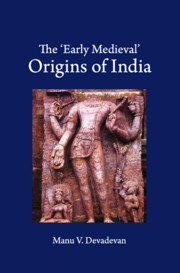Book contents
- Frontmatter
- Dedication
- Contents
- List of Tables
- List of Maps and Figures
- Acknowledgements
- 1 Introduction
- I INSTITUTIONS
- 2 State Formation and Its Structural Foundations
- 3 From the Cult of Chivalry to the Cult of Personality: The Seventh- Century Transformation in Pallava Statecraft
- 4 Changes in Land Relations and the Changing Fortunes of the Cēra State
- 5 Temple and Territory in the Puri Jagannātha Imaginaire
- II IDEAS
- 6 Svayaṃbuddha's Predilections: The Epistemologies of Time and Knowledge
- 7 Bhāravi and the Creation of a Literary Paradigm
- 8 Knowing and Being: The Semantic Universe of the Kūḍiyāṭṭaṃ Theatre
- 9 The Invention of Zero and Its Intellectual Legacy
- III IDENTITIES
- 10 The Evolution of Vernacular Languages: A Case Study of Kannada
- 11 Religious Identities in Times of Indumauḷi's Grief
- 12 Caste, Gender, and the Landed Patriarchy
- 13 The Making of Territorial Self Consciousness (with Particular Reference to Kaliṅga)
- Bibliography
- Index
7 - Bhāravi and the Creation of a Literary Paradigm
Published online by Cambridge University Press: 02 May 2020
- Frontmatter
- Dedication
- Contents
- List of Tables
- List of Maps and Figures
- Acknowledgements
- 1 Introduction
- I INSTITUTIONS
- 2 State Formation and Its Structural Foundations
- 3 From the Cult of Chivalry to the Cult of Personality: The Seventh- Century Transformation in Pallava Statecraft
- 4 Changes in Land Relations and the Changing Fortunes of the Cēra State
- 5 Temple and Territory in the Puri Jagannātha Imaginaire
- II IDEAS
- 6 Svayaṃbuddha's Predilections: The Epistemologies of Time and Knowledge
- 7 Bhāravi and the Creation of a Literary Paradigm
- 8 Knowing and Being: The Semantic Universe of the Kūḍiyāṭṭaṃ Theatre
- 9 The Invention of Zero and Its Intellectual Legacy
- III IDENTITIES
- 10 The Evolution of Vernacular Languages: A Case Study of Kannada
- 11 Religious Identities in Times of Indumauḷi's Grief
- 12 Caste, Gender, and the Landed Patriarchy
- 13 The Making of Territorial Self Consciousness (with Particular Reference to Kaliṅga)
- Bibliography
- Index
Summary
At about the time when Bhartṛhari was breaking new grounds with his ingenious theory of time, a new paradigm of literary production and imagination made its appearance in the Indian subcontinent. It was the brainchild of a poet of profound originality, Bhāravi, and found expression in the only known work of his, the Kirātārjunīya. This work, which is in our times often inveighed against in the open even as it is taken with in stealth, has earned recognition in the Sanskrit literary canon as one of the five masterpieces of literature (pañcamahākāvya) in the language. The text marked a decisive departure from existing paradigms of literary production, so much so that it is possible with historical hindsight to tell a pre-Bhāravi period from a post-Bhāravi period in the history of kāvya literature in Sanskrit in the first millennium CE. Bhāravi's paradigm was to remain hegemonic for over a thousand years before it eventually began to jostle for space with a new paradigm that arose in the early sixteenth century. Even later, the Kirātārjunīya remained influential and lost little of its brilliance. Its appeal rested not merely on the unique manner in which imagination was configured in it, which is certainly an aspect of the text that cannot be overlooked. At a functional level, the text provided a dependable and clearly defined model for crafting a literary text, which could be learnt through practice and reproduced with ease. In both respects, Bhāravi's text scored over earlier literary models that the works of Vālmīki, Aśvaghōṣa, and Kālidāsa have represented.
Bhāravi's literary paradigm is important for us not only for the perspective it makes available for studying the praxis of literature in Sanskrit. At a more general level, there is embedded in its representative structure a new attitude to the question of the self, which informed such widely different spheres of representations as love and life in poetry, chivalrous death recorded in hero stones, the theory of the absolute in Śaṅkara's advaita, and aesthetic principles in poetics. In other words, the ideology (understood here as false consciousness) of the self that appeared in the Kirātārjunīya was not merely part of the tropes of representation in literature.
- Type
- Chapter
- Information
- The ‘Early Medieval' Origins of India , pp. 209 - 224Publisher: Cambridge University PressPrint publication year: 2020



